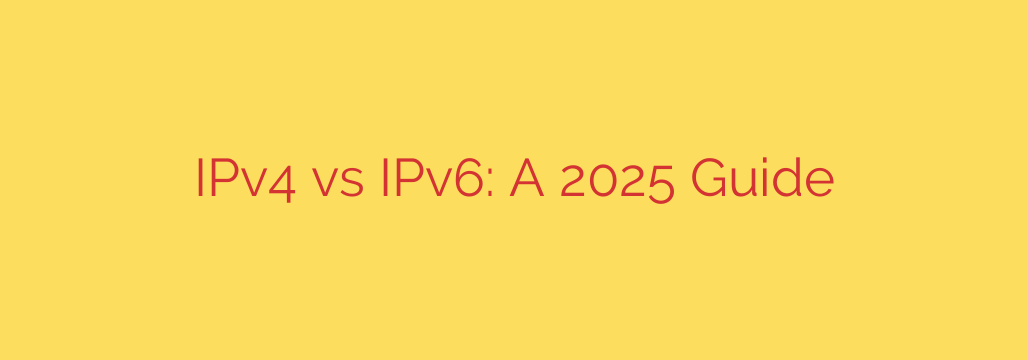
IPv4 vs. IPv6: Understanding the Future of the Internet in 2025
Every device that connects to the internet—from your smartphone and laptop to your smart TV and doorbell—needs a unique address to send and receive information. This digital address is known as an Internet Protocol (IP) address. For decades, the internet has run on a system called IPv4, but its limitations are paving the way for its successor, IPv6.
Understanding the difference between IPv4 and IPv6 isn’t just for network engineers anymore. As we move deeper into a hyper-connected world, this transition impacts everything from online security to the growth of new technologies. Here’s what you need to know about the two protocols and why the future is built on IPv6.
What is IPv4? The Protocol That Built the Internet
IPv4 (Internet Protocol version 4) has been the workhorse of the internet since its early days. It uses a 32-bit address structure, which you’ve likely seen before. It looks like this: 192.168.1.1.
This 32-bit system provides approximately 4.3 billion unique addresses. In the 1980s, this seemed like an inexhaustible number. However, with the explosive growth of personal computers, smartphones, servers, and now the Internet of Things (IoT), we have effectively run out of new IPv4 addresses.
To cope with this shortage, technologies like Network Address Translation (NAT) were created. NAT allows multiple devices on a local network (like in your home or office) to share a single public IPv4 address. While clever, this is a workaround that adds complexity and can create connectivity issues for certain applications.
Enter IPv6: The Next-Generation Solution
IPv6 (Internet Protocol version 6) was designed as the long-term solution to IPv4’s address exhaustion problem. It uses a much larger 128-bit address structure, which looks like this: 2001:0db8:85a3:0000:0000:8a2e:0370:7334.
The jump from 32-bit to 128-bit is monumental. IPv6 provides an almost unimaginably vast number of unique addresses—roughly 340 undecillion (3.4 x 10^38). To put that in perspective, that’s more than enough to assign an IP address to every single atom on the surface of the Earth. Address exhaustion is no longer a concern.
But IPv6 offers more than just a massive address pool. It was designed to improve upon IPv4 in several key areas.
Key Differences: IPv4 vs. IPv6 Head-to-Head
While the primary difference is the address space, several other critical improvements make IPv6 a superior protocol for the modern internet.
1. Address Space and Format
- IPv4: 32-bit, providing ~4.3 billion addresses. Written in dot-decimal notation.
- IPv6: 128-bit, providing ~340 undecillion addresses. Written in hexadecimal notation.
2. Security
- This is a major advantage for IPv6. IPsec (Internet Protocol Security) is a mandatory, built-in component of IPv6. IPsec provides end-to-end encryption and authentication, ensuring that data packets are secure from tampering or interception.
- In IPv4, IPsec is an optional add-on, meaning it isn’t universally implemented, leaving security more fragmented.
3. Performance and Efficiency
- IPv6 features a simplified packet header. By removing unnecessary and optional fields from the header, routers can process IPv6 packets more quickly and efficiently.
- IPv6 eliminates the need for NAT. Because every device can have its own unique public IP address, direct end-to-end connections are possible. This improves performance for applications like online gaming, VoIP, and peer-to-peer file sharing.
4. Network Configuration
- IPv6 introduces SLAAC (Stateless Address Autoconfiguration). This feature allows devices to automatically configure their own IP address as soon as they connect to a network, without needing a separate DHCP server.
- This simplifies network management, especially for large networks with countless connected devices.
Why the Transition Matters Now More Than Ever
The shift to IPv6 isn’t happening overnight, but its momentum is undeniable in 2025. Here’s why it’s so important:
- The Internet of Things (IoT): Smart homes, connected cars, industrial sensors, and wearable tech all rely on having a unique IP address. IPv4 cannot support this scale, making IPv6 the essential backbone for the continued growth of IoT.
- Future-Proofing: Businesses and service providers that fail to adopt IPv6 risk being left behind. As more of the internet becomes IPv6-native, those still running on IPv4-only networks may face compatibility and performance issues.
- Global Adoption: Major content providers like Google, Meta (Facebook), and Netflix have been serving content over IPv6 for years. A significant portion of global internet traffic is now carried over IPv6, and this trend is only accelerating.
Actionable Security Tips for the IPv6 Transition
For most home users, the transition will be seamless. Your Internet Service Provider (ISP) and modern router likely already support IPv6 and handle the configuration automatically. You can check your own connectivity by visiting a test site like test-ipv6.com.
For businesses and network administrators, a proactive approach is crucial:
- Conduct an Audit: Review your network hardware (routers, switches, firewalls) and software applications to ensure they are fully IPv6 compatible.
- Enable Dual-Stack: Run both IPv4 and IPv6 simultaneously on your network. This “dual-stack” approach ensures a smooth transition without interrupting service for users who can only connect via one protocol.
- Update Security Policies: Your firewall and security policies must be configured to manage IPv6 traffic just as robustly as you manage IPv4. A common mistake is securing the IPv4 network while leaving IPv6 traffic unmonitored, creating a major security vulnerability.
The move from IPv4 to IPv6 is a necessary evolution. It’s an upgrade that provides the space, security, and efficiency required to power the next generation of internet innovation. While IPv4 will remain in use for some time, the future of digital connectivity is undeniably built on the solid foundation of IPv6.
Source: https://www.redswitches.com/blog/ipv4-vs-ipv6-in-2025/








